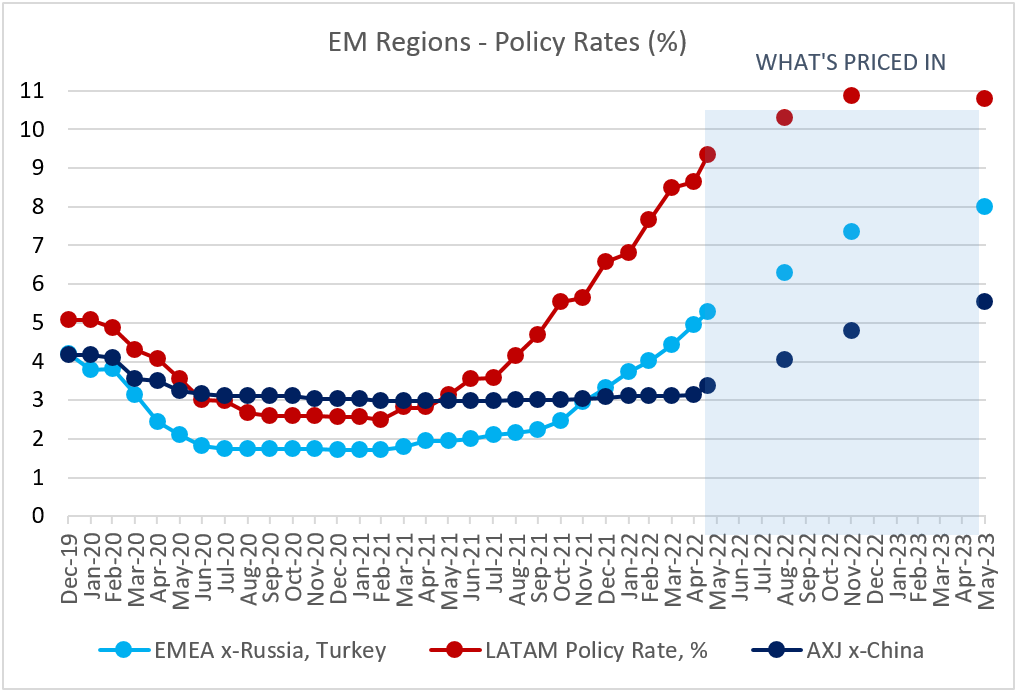By Natalia Gurushina
Chief Economist, Emerging Markets Fixed Income
Philippines joined EM Asia policy rate’s liftoff with a hawkish hike. South Africa stepped up rate hikes, even though inflation is still within the target.
Em Asia Policy Liftoff
A hawkish liftoff in EM Asia continued this morning, with the Philippine central bank (BSP) delivering a hawkish 25bps rate hike in both the overnight borrowing rate and the standing overnight deposit rate (only the former was expected). The BSP responded to higher price pressures that pushed headline inflation outside the official target range, making it the third regional central bank in a row (together with India and Malaysia) to surprise the market on the hawkish side. The market now prices in a fairly brisk tightening cycle in EM Asia (see chart below), with around 200bps of rate hikes expected in the next year or so. One thing we keep an eye on is policy divergence between China and the rest of Asia – would more aggressive rate hikes outside of China help to de-anchor Asia FX from the Chinese renminbi’s weakness going forward?
Latam Policy Rates – Peak In Sight?
EM Asia started to tighten in earnest more than a year after the inaugural rate hikes in LATAM. The latter is still in the midst of the tightening cycle – Brazil, Mexico, Chile, Peru, and Uruguay raised their policy rates this month – but all good things eventually come to an end. Even rate hikes. “We the market” are now seeing policy rates in LATAM peaking by November (see chart below), leaving most countries with stronger policy cushions, somewhat better than expected growth (2022 GDP projections have been grinding higher in the LATAM for some time now), and maybe an upside surprise or two in fiscal performance.
Emea Rate Hikes – Too Slow?
As regards EMEA, the policy direction is right (tightening), but the speed of hikes might be too slow for the kind of inflation pressures the region is facing right now. Fortunately, this does not apply to South Africa’s super-credible central bank, which delivered expected +50bps today (a step up compared to the previous rate-setting meeting) without too much drama, and while headline inflation is still within the target. The South African rand loved every minute of it, rallying the most among major EM currencies (139bps against the U.S. Dollar, as of 10:05am ET, according to Bloomberg LP). Stay tuned!
Chart at a Glance: EM Policy Rates – Peak Still Far Away

Source: VanEck Research; Bloomberg LP
PMI – Purchasing Managers’ Index: economic indicators derived from monthly surveys of private sector companies. A reading above 50 indicates expansion, and a reading below 50 indicates contraction; ISM – Institute for Supply Management PMI: ISM releases an index based on more than 400 purchasing and supply managers surveys; both in the manufacturing and non-manufacturing industries; CPI – Consumer Price Index: an index of the variation in prices paid by typical consumers for retail goods and other items; PPI – Producer Price Index: a family of indexes that measures the average change in selling prices received by domestic producers of goods and services over time; PCE inflation – Personal Consumption Expenditures Price Index: one measure of U.S. inflation, tracking the change in prices of goods and services purchased by consumers throughout the economy; MSCI – Morgan Stanley Capital International: an American provider of equity, fixed income, hedge fund stock market indexes, and equity portfolio analysis tools; VIX – CBOE Volatility Index: an index created by the Chicago Board Options Exchange (CBOE), which shows the market’s expectation of 30-day volatility. It is constructed using the implied volatilities on S&P 500 index options.; GBI-EM – JP Morgan’s Government Bond Index – Emerging Markets: comprehensive emerging market debt benchmarks that track local currency bonds issued by Emerging market governments; EMBI – JP Morgan’s Emerging Market Bond Index: JP Morgan’s index of dollar-denominated sovereign bonds issued by a selection of emerging market countries; EMBIG – JP Morgan’s Emerging Market Bond Index Global: tracks total returns for traded external debt instruments in emerging markets.
The information presented does not involve the rendering of personalized investment, financial, legal, or tax advice. This is not an offer to buy or sell, or a solicitation of any offer to buy or sell any of the securities mentioned herein. Certain statements contained herein may constitute projections, forecasts and other forward looking statements, which do not reflect actual results. Certain information may be provided by third-party sources and, although believed to be reliable, it has not been independently verified and its accuracy or completeness cannot be guaranteed. Any opinions, projections, forecasts, and forward-looking statements presented herein are valid as the date of this communication and are subject to change. The information herein represents the opinion of the author(s), but not necessarily those of VanEck.
Investing in international markets carries risks such as currency fluctuation, regulatory risks, economic and political instability. Emerging markets involve heightened risks related to the same factors as well as increased volatility, lower trading volume, and less liquidity. Emerging markets can have greater custodial and operational risks, and less developed legal and accounting systems than developed markets.
All investing is subject to risk, including the possible loss of the money you invest. As with any investment strategy, there is no guarantee that investment objectives will be met and investors may lose money. Diversification does not ensure a profit or protect against a loss in a declining market. Past performance is no guarantee of future performance.






